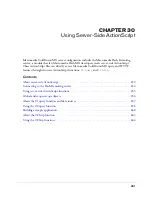
Using the Flash Remoting service with ColdFusion pages
643
Using the Flash Remoting service with ColdFusion pages
When building a ColdFusion page that interacts with Flash movies, the directory name that
contains the ColdFusion pages translates to the Flash service name in ActionScript. The
individual ColdFusion page names contained in that directory translate to service functions in
ActionScript.
In your CFML, you use the Flash variable scope to access parameters passed from Flash movies
and return values to Flash movies. To access parameters passed from Flash movies, you use the
parameter name appended to the
Flash
variable or the
Flash.Params
array. To return values to
the Flash application, use the
Flash.Result
variable. To set an increment value for records to be
returned to the Flash application, use the
Flash.Pagesize
variable.
The following table shows the variables contained in the Flash scope:
In addition, the following table compares the ColdFusion data types and their ActionScript
equivalents:
Variable
Description
For more information
Flash.Params
A structure containing the
parameters passed from the Flash
movie.
See
“Accessing parameters passed from
Flash” on page 644
.
Flash.Result
The variable returned to the Flash
movie that called the function.
See
“Returning results to Flash”
on page 645
.
Flash.Pagesize
The number of records returned at a
time to Flash.
See
“Returning records in increments to
Flash” on page 645
.
ActionScript data type
ColdFusion MX data type
Number (primitive data type) Number
boolean (primitive data type) boolean
String
String
ActionScript (AS) object
Structure
AS Object (as the only
argument passed to a service
function)
Arguments to the service function. ColdFusion pages (.cfm):
flash
variable scope, ColdFusion components (.cfc): named arguments
null
null (ASC returns 0, which translates to not defined)
undefined
null (ASC returns 0, which translates to not defined)
Ordered array
Array
Named array
Struct
Date object
Date
XML object
XML document
RecordSet
Query object
Summary of Contents for ColdFusion MX
Page 1: ...Developing ColdFusion MX Applications...
Page 22: ...22 Contents...
Page 38: ......
Page 52: ...52 Chapter 2 Elements of CFML...
Page 162: ......
Page 218: ...218 Chapter 10 Writing and Calling User Defined Functions...
Page 250: ...250 Chapter 11 Building and Using ColdFusion Components...
Page 264: ...264 Chapter 12 Building Custom CFXAPI Tags...
Page 266: ......
Page 314: ...314 Chapter 14 Handling Errors...
Page 344: ...344 Chapter 15 Using Persistent Data and Locking...
Page 349: ...About user security 349...
Page 357: ...Security scenarios 357...
Page 370: ...370 Chapter 16 Securing Applications...
Page 388: ...388 Chapter 17 Developing Globalized Applications...
Page 408: ...408 Chapter 18 Debugging and Troubleshooting Applications...
Page 410: ......
Page 426: ...426 Chapter 19 Introduction to Databases and SQL...
Page 476: ...476 Chapter 22 Using Query of Queries...
Page 534: ...534 Chapter 24 Building a Search Interface...
Page 556: ...556 Chapter 25 Using Verity Search Expressions...
Page 558: ......
Page 582: ...582 Chapter 26 Retrieving and Formatting Data...
Page 668: ......
Page 734: ...734 Chapter 32 Using Web Services...
Page 760: ...760 Chapter 33 Integrating J2EE and Java Elements in CFML Applications...
Page 786: ...786 Chapter 34 Integrating COM and CORBA Objects in CFML Applications...
Page 788: ......
















































